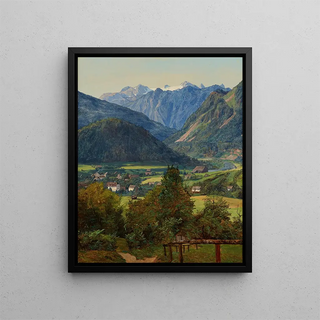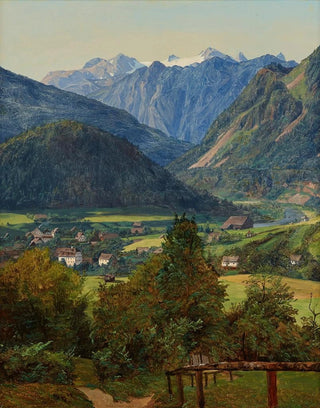Art print of Le Dachstein from Sophien-Doppelblick near Ischl - Ferdinand Georg Waldmüller | Art print


View from behind

Frame (optional)
The art print "Le Dachstein de Sophien-Doppelblick près d'Ischl" by Ferdinand Georg Waldmüller is a true ode to nature, capturing the majesty of Austrian landscapes with remarkable finesse. This painting, which evokes the serenity of the mountains and the beauty of the skies, transports the viewer on a visual journey where every detail seems to resonate with perfect harmony. Waldmüller, known for his realistic approach and carefully crafted compositions, succeeds here in immortalizing a fleeting moment of light and color, offering a striking vision of nature. The depiction of this alpine panorama is not only a testament to his talent but also an invitation to contemplate the grandeur of the natural world.
Style and uniqueness of the work
Waldmüller's style is distinguished by his ability to blend realism and romanticism. In "Le Dachstein de Sophien-Doppelblick près d'Ischl," he uses delicate brushstrokes to render the texture of the mountains and the fluidity of the clouds. The color palette, both soft and vibrant, evokes a peaceful and contemplative atmosphere. Waldmüller manages to create impressive depth, where the different layers of the composition seem to extend infinitely. The play of light, subtly orchestrated, highlights the nuances of rocks and vegetation, while imparting an almost spiritual dimension to the work. This stylistic singularity makes this painting an emblematic example of romantic landscape art, where nature is celebrated not only for its beauty but also for its emotional power.
The artist and his influence
Ferdinand Georg Waldmüller, born in 1793 in Vienna, is a key figure in Austrian art of the 19th century. His career spans several decades, during which he evolved and experimented with various styles. Influenced by the Romantic movement, he was also shaped by the artistic traditions of his country. Waldmüller played a pivotal role in the development of landscape as an artistic genre, redefining conventions and incorporating elements of daily life into his works. His innovative approach has inspired many

Matte finish

View from behind

Frame (optional)
The art print "Le Dachstein de Sophien-Doppelblick près d'Ischl" by Ferdinand Georg Waldmüller is a true ode to nature, capturing the majesty of Austrian landscapes with remarkable finesse. This painting, which evokes the serenity of the mountains and the beauty of the skies, transports the viewer on a visual journey where every detail seems to resonate with perfect harmony. Waldmüller, known for his realistic approach and carefully crafted compositions, succeeds here in immortalizing a fleeting moment of light and color, offering a striking vision of nature. The depiction of this alpine panorama is not only a testament to his talent but also an invitation to contemplate the grandeur of the natural world.
Style and uniqueness of the work
Waldmüller's style is distinguished by his ability to blend realism and romanticism. In "Le Dachstein de Sophien-Doppelblick près d'Ischl," he uses delicate brushstrokes to render the texture of the mountains and the fluidity of the clouds. The color palette, both soft and vibrant, evokes a peaceful and contemplative atmosphere. Waldmüller manages to create impressive depth, where the different layers of the composition seem to extend infinitely. The play of light, subtly orchestrated, highlights the nuances of rocks and vegetation, while imparting an almost spiritual dimension to the work. This stylistic singularity makes this painting an emblematic example of romantic landscape art, where nature is celebrated not only for its beauty but also for its emotional power.
The artist and his influence
Ferdinand Georg Waldmüller, born in 1793 in Vienna, is a key figure in Austrian art of the 19th century. His career spans several decades, during which he evolved and experimented with various styles. Influenced by the Romantic movement, he was also shaped by the artistic traditions of his country. Waldmüller played a pivotal role in the development of landscape as an artistic genre, redefining conventions and incorporating elements of daily life into his works. His innovative approach has inspired many
12,34 €






